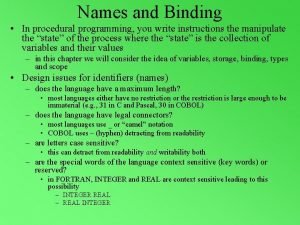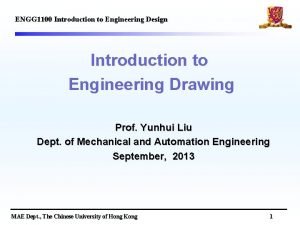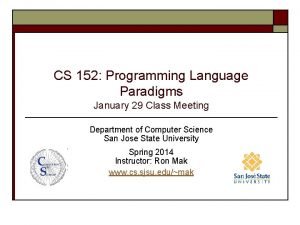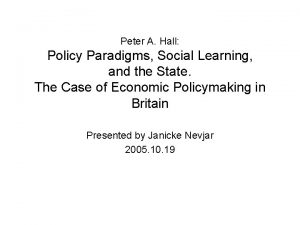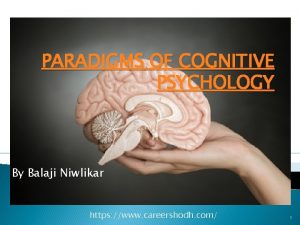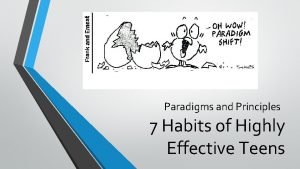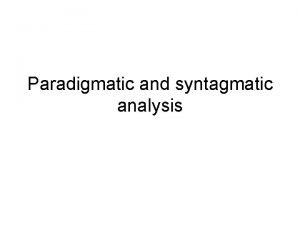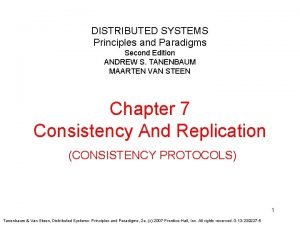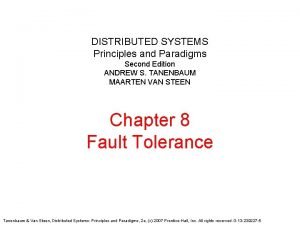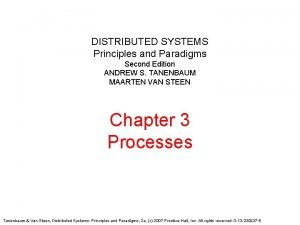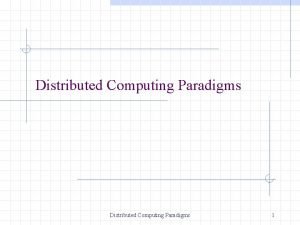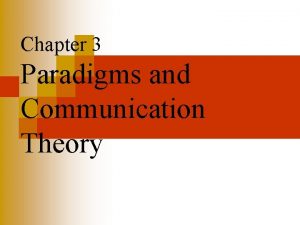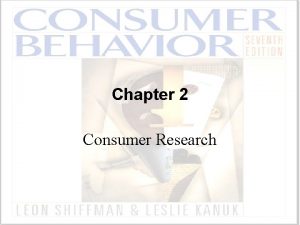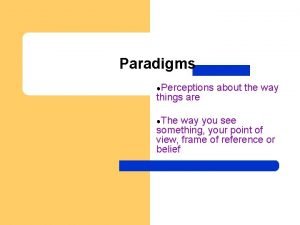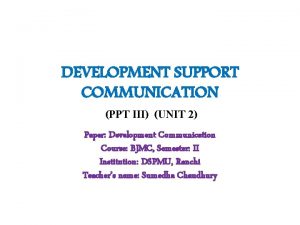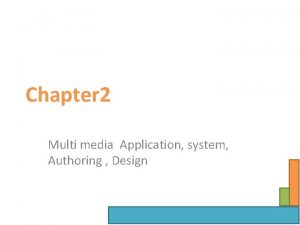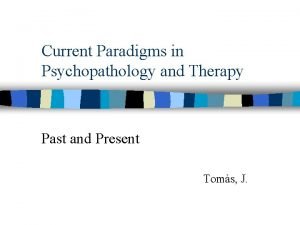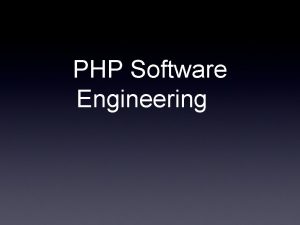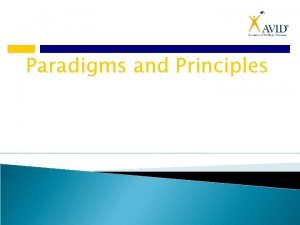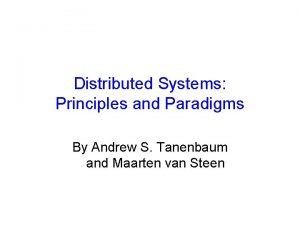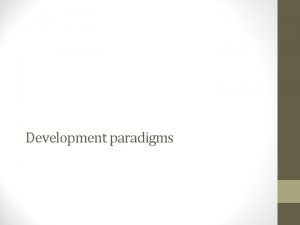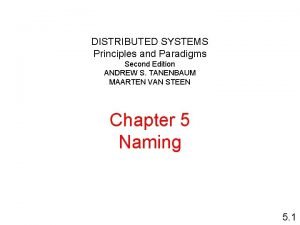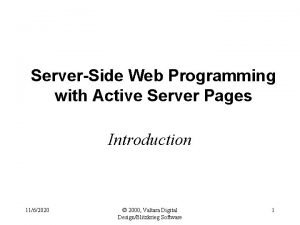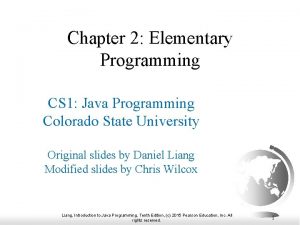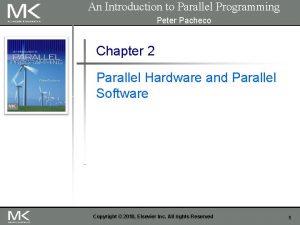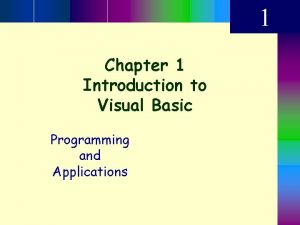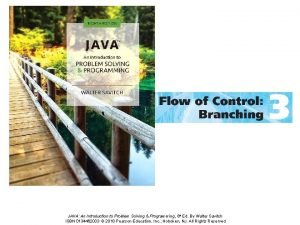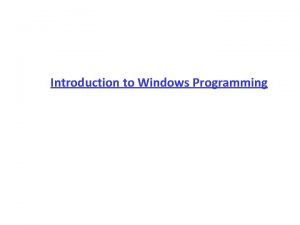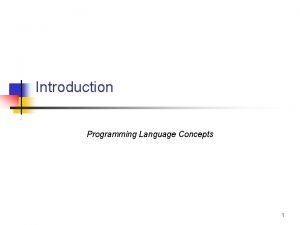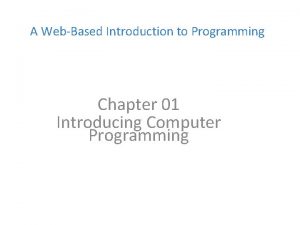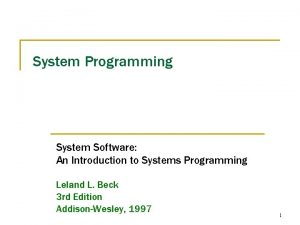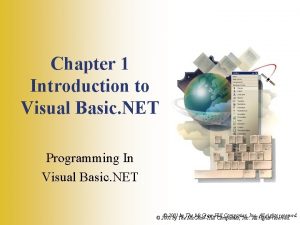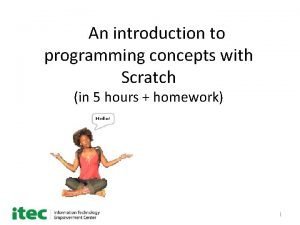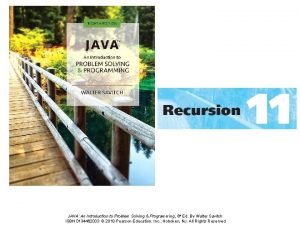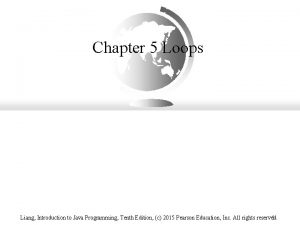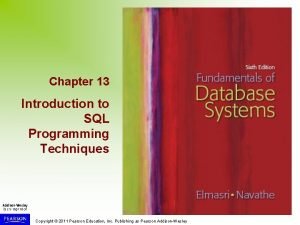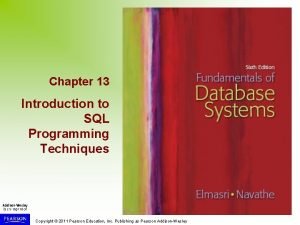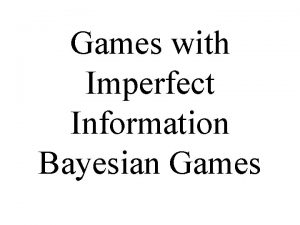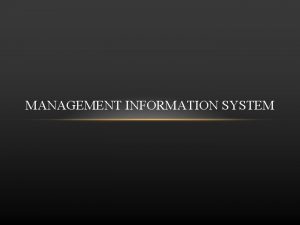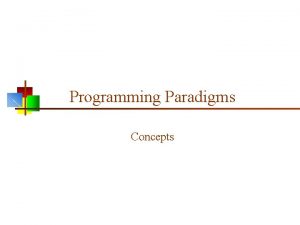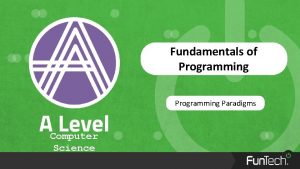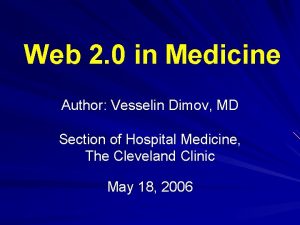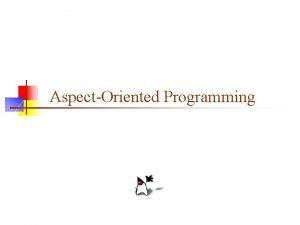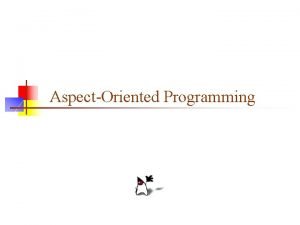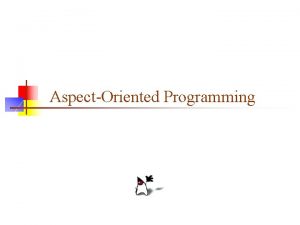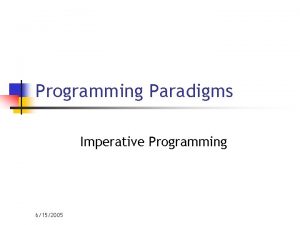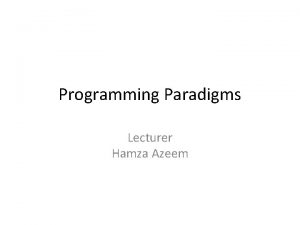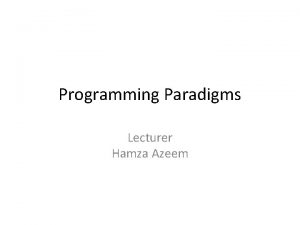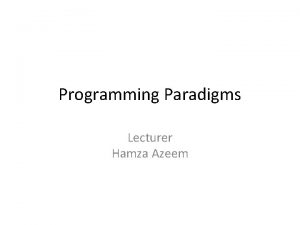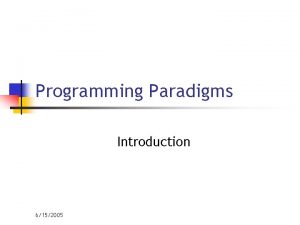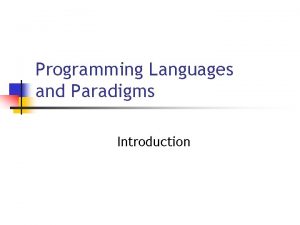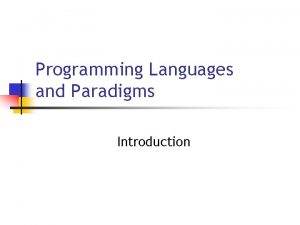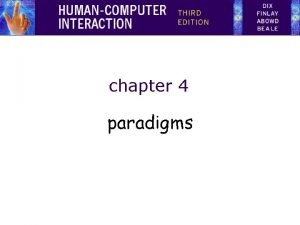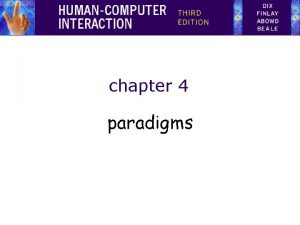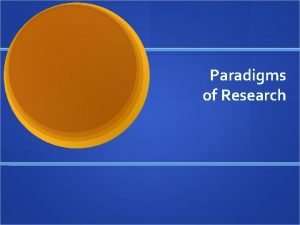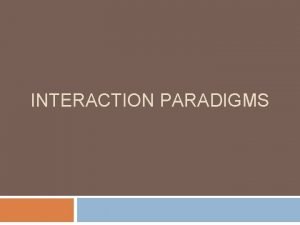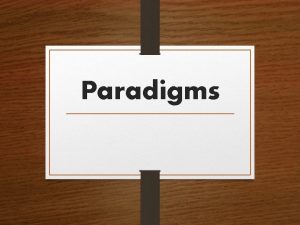Introduction Programming Paradigms Information Lecturer Vesselin Evgueniev Gueorguiev











































































- Slides: 75

Introduction Programming Paradigms

Information Ä Lecturer: Vesselin Evgueniev Gueorguiev ü room: 2300 A ü e-mail: veg@tu-sofia. bg û Subject: FDIBA student Ä Course materials: ü url: http: //pct. tu-sofia. bg/moodle 001/course/category. php? id=59 û Username: student û Password: pktt Ä Exam ü Duration: 3 hours ü Type of exam: û Test with 60 questions: single choice, multiple choice, re-ordering, arrange in groups, missing link in diagrams, select and connect, etc.

Readings Ä Textbooks: ü P. van Roy, S. Haridi, “Concepts, Techniques, and Models of Computer Programming” ü R. W. Sebesta, “Concepts of Programming Languages, ” 10 th edition ü K. C. Louden, K. A. Lambert, “Programming Languages: Principles and Practice”, 3 rd Edition Ä Additional readings: ü All books and papers about …

Computer? What is this?

Data processors Ä Let us define a computer as a data processor. ü Using this definition, a computer acts as a black box that accepts input data, processes the data, and creates output data. ü Although this model can define the functionality of a computer today, it is too general. û In this model, a pocket calculator is also a computer (which it is, in a literal sense).

Programmable data processors Ä The Turing model is a better model for a general-purpose computer. ü This model adds an extra element to the specific computing machine: the program. ü A program is a set of instructions that tells the computer what to do with data.

Turing machine Ä The idea of a universal computational device was first described by Alan Turing in 1937. Ä Ä He proposed that all computation could be performed by a special kind of a machine, now called a Turing machine. He based the model on the actions that people perform when involved in computation. He abstracted these actions into a model for a computational machine that has really changed the world. A Turing machine is made of three components: a tape, a controller and a read/write head

Turing machine components Ä Tape ü Although modern computers use a random-access storage device with finite capacity, we assume that the Turing machine’s memory is infinite. ü The tape, at any one time, holds a sequence of characters from the set of characters accepted by the machine. ü For our purpose, we assume that the machine can accept only two symbols: a blank (b) and digit 1.

Turing machine components Ä Read/write head ü The read/write head at any moment points to one symbol on the tape. û We call this symbol the current symbol. ü The read/write head reads and writes one symbol at a time from the tape. û After reading and writing, it moves to the left or to the right. ü Reading, writing and moving are all done under instructions from the controller.

Turing machine components Ä Controller ü The controller is theoretical counterpart of the central processing unit (CPU) in modern computers. û It is a finite state automaton, a machine that has a predetermined finite number of states and moves from one state to another based on the input. Ä Transition state diagram for the Turing machine

Universal Turing machine Ä A universal Turing machine, a machine that can do any computation if the appropriate program is provided, was the first description of a modern computer. ü It can be proved that a very powerful computer and a universal Turing machine can compute the same thing. ü We need only provide the data and the program – the description of how to do the computation – to either machine. Ä In fact, a universal Turing machine is capable of computing anything that is computable.

von NEUMANN model Ä Computers built on the Turing universal machine store data in their memory. Ä Around 1944– 1945, John von Neumann proposed that, since program and data are logically the same, programs should also be stored in the memory of a computer. ü Four subsystems: memory, arithmetic logic unit, control unit, and input/output.

The stored program concept Ä The von Neumann model states that the program must be stored in memory. ü This is totally different from the architecture of early computers in which only the data was stored in memory: the programs for their task was implemented by manipulating a set of switches or by changing the wiring system. Ä The memory of modern computers hosts both a program and its corresponding data. ü This implies that both the data and programs should have the same format, because they are stored in memory. ü In fact, they are stored as binary patterns in memory – a sequence of 0 s and 1 s.

Sequential execution of instructions Ä A program in the von Neumann model is made of a finite number of instructions. ü In this model, the control unit fetches one instruction from memory, decodes it, then executes it. û In other words, the instructions are executed one after another. ü Of course, one instruction may request the control unit to jump to some previous or following instruction, but this does not mean that the instructions are not executed sequentially. Ä Sequential execution of a program was the initial requirement of a computer based on the von Neumann model. ü Today’s computers execute programs in the order that is the most efficient.

Computers & Data

Storing data Ä Data today comes in different forms including numbers, text, audio, image and video.

Storing numbers Ä A number is changed to the binary system before being stored in the computer memory. Ä However, there are still two issues that need to be handled: ü How to store the sign of the number. ü How to show the decimal point.

Storing integers Ä Integers are whole numbers (numbers without a fractional part). ü For example, 134 and − 125 are integers, whereas 134. 23 and − 0. 235 are not. Ä An integer can be thought of as a number in which the position of the decimal point is fixed: the decimal point is to the right of the least significant (rightmost) bit. ü For this reason, fixed-point representation is used to store an û In this representation the decimal point is assumed but not stored integer.

Unsigned representation Ä An unsigned integer is an integer that can never be negative and can take only 0 or positive values. ü Its range is between 0 and positive infinity. Ä An input device stores an unsigned integer using the following steps: ü The integer is changed to binary. ü If the number of bits is less than n, 0 s are added to the left.

Sign-and-magnitude representation Ä In this method, the available range for unsigned integers (0 to 2 n − 1) is divided into two equal sub-ranges. ü The first half represents positive integers, the second half, negative integers. ü In sign-and-magnitude representation, the leftmost bit defines the sign of the integer. û If it is 0, the integer is positive. û If it is 1, the integer is negative.

Integer data Ä One’s complementing: ü This operation simply reverses (flips) each bit. A 0 -bit is changed to a 1 -bit, a 1 -bit is changed to a 0 -bit. Ä Two’s complement integers ü Almost all computers use two’s complement representation to store a signed integer in an n-bit memory location. û In this method, the available range for an unsigned integer of (0 to 2 n − 1) is divided into two equal sub-ranges.

Integer data Ä How calculate two’s complement integers ? ü Method 1: First, we take the one’s complement and then add 1 to the result. ü Method 2: First, we copy bits from the right until a 1 is copied; then, we flip the rest of the bits.

Storing reals Ä A real is a number with an integral part and a fractional part. ü Example: 14. 3 is a real number – the integral part is 14 and the fractional part is 3/10. ü Real numbers with very large integral parts or very small fractional parts should not be stored in fixed-point representation û Although a fixed-point representation can be used to represent a real number, the result may not be accurate or it may not have the required precision. û Example 1: We use a fixed-point representation with two digits at the right of the decimal point and fourteen digits at the left of the decimal point, for a total of sixteen digits (in the decimal system). The precision of a real number in this system is lost if we try to represent a decimal number such as 1. 00234 because the system stores the number as 1. 00.

Storing reals Ä A real is a number with an integral part and a fractional part. ü Example: 14. 3 is a real number – the integral part is 14 and the fractional part is 3/10. ü Real numbers with very large integral parts or very small fractional parts should not be stored in fixed-point representation û Although a fixed-point representation can be used to represent a real number, the result may not be accurate or it may not have the required precision. û Example 2: We use a fixed-point representation with six digits to the right of the decimal point and ten digits for the left of the decimal point, for a total of sixteen digits (In the decimal system). The accuracy of a real number in this system is lost if we try to represent a decimal number such as 236154302345. 00. The system stores the number as 6154302345. 00 because the integral part is much smaller than it should be.

Floating-point representation Ä The solution for maintaining accuracy or precision is to use floating-point representation. ü A floating point representation of a number is made up of three parts: a sign, a shifter and a fixed-point number. ü Example (decimal numbers): sign Fixed-point part shifter

Floating-point representation Ä The solution for maintaining accuracy or precision is to use floating-point representation. ü A floating point representation of a number is made up of three parts: a sign, a shifter and a fixed-point number. ü Example (decimal numbers):

Floating-point representation Ä The solution for maintaining accuracy or precision is to use floating-point representation. ü A floating point representation of a number is made up of three parts: a sign, a shifter and a fixed-point number. ü Example (binary numbers):

Normalization Ä To make the fixed part of the representation uniform, both the scientific method (for the decimal system) and the floatingpoint method (for the binary system) use only one non-zero digit on the left of the decimal point. ü This is called normalization. ü In the decimal system this digit can be 1 to 9, while in the binary system it can only be 1. In the following, d is a non-zero digit, x is a digit, and y is either 0 or 1.

Normalization Ä Note that the point and the bit 1 to the left of the fixed-point section are not stored—they are implicit. ü The mantissa is a fractional part that, together with the sign, is treated like an integer stored in sign-and-magnitude representation.

Excess System Ä The exponent, the power that shows how many bits the decimal point should be moved to the left or right, is a signed number. ü Although this could have been stored using two’s complement representation, a new representation, called the Excess system, is used instead. Ä In the Excess system, both positive and negative integers are stored as unsigned integers. ü To represent a positive or negative integer, a positive integer (called a bias) is added to each number to shift them uniformly to the nonnegative side. ü The value of this bias is 2 m− 1 − 1, where m is the size of the memory location to store the exponent

Excess System Ä Example: ü We can express sixteen integers in a number system with 4 -bit allocation. By adding seven units to each integer in this range, we can uniformly translate all integers to the right and make all of them positive without changing the relative position of the integers with respect to each other, as shown in the figure. The new system is referred to as Excess-7, or biased representation with biasing value of 7.

IEEE Standard Ä Single precision (Excess_127) Ä Double precision (Excess_1023)

IEEE Standard Ä Example: Show the Excess_127 (single precision) representation of the decimal number – 161. 875 ü The sign is negative, so S = 1. 1 ü Decimal to binary transformation: 161. 875= (10100001. 111)2. ü Normalization: (10100001. 111)2 = (1. 0100001111)2 × 27. 27 ü E = 7 + 127 = 134 = (10000110)2 and M = (0100001111)2. ü Representation: ü The number is stored in the computer as 1100001101000011110000000

IEEE Standard Ä Example: Show the Excess_127 (single precision) representation of the decimal number – 0. 0234375 ü The sign is negative, so S = 1. 1 ü Decimal to binary transformation: 0. 0234375 = (0. 0000011)2. ü Normalization: (0. 0000011)2 = (1. 1)2 × 2− 6. ü E = – 6 + 127 = 121 = (01111001)2 and M = (1)2. ü Representation: ü The number is stored in the computer as 101111000000000000

IEEE Standard Ä Example: The bit pattern (11001010000011100001111)2 is stored in Excess_127 format. Show the value in decimal. ü Sign, Exponent, Mantissa ü The sign is negative ü The shifter = E − 127 = 148 − 127 = 21. 21 ü This gives us (1. 000011100001111)2 × 221 ü The binary number is (10000111000011. 11)2 ü The absolute value is 2104378. 75 ü The number is − 2104378. 75

Overflow and Underflow Ä Overflow and underflow ü –Largest = -(1 - 2 -24) × 2+128 ü +Largest = +(1 - 2 -24) × 2+128 ü –Smallest = -(1 - 2 -1) × 2 -127 ü +Largest = +(1 - 2 -1) × 2 -127 Ä Storing Zero ü A real number with an integral part and the fractional part set to zero (0. 0), cannot be stored using the steps discussed above. û To handle this special case, it is agreed that in this case the sign, exponent and the mantissa are set to 0 s.

Storing text Ä A section of text in any language is a sequence of symbols used to represent an idea in that language. For example, the English language uses 26 symbols (A, B, C, …, Z) to represent uppercase letters, 26 symbols (a, b, c, …, z) to represent lowercase letters, nine symbols (0, 1, 2, …, 9) to represent numeric characters and symbols (. , ? , : , ; , …, !) to represent punctuation. ü Other symbols such as blank, newline, and tab are used for text alignment and readability. ü We can represent each symbol with a bit pattern. ü Ä Codes ü ü ü ASCII Unicode Other Codes

Storing audio Ä Audio is a representation of sound or music. ü Audio, by nature, is different to the numbers or text. û Text is composed of countable entities (characters): we can count the number of characters in text. û Text is an example of digital data. ü Audio is not countable. ü Audio is an example of analog data. û Even if we are able to measure all its values in a period of time, we cannot store these in the computer’s memory, as we would need an infinite number of memory locations.

Sampling Ä If we cannot record all the values of a an audio signal over an interval, we can record some of them. ü Sampling means that we select only a finite number of points on the analog signal, measure their values, and record them.

Quantization Ä The value measured for each sample is a real number. ü This means that we can store 40, 000 real values for each one second sample. ü However, it is simpler to use an unsigned integer (a bit pattern) for each sample. Ä Quantization refers to a process that rounds the value of a sample to the closest integer value. ü For example, if the real value is 17. 2, it can be rounded down to 17: if the value is 17. 7, it can be rounded up to 18.

Encoding Ä The quantized sample values need to be encoded as bit patterns. ü Some systems assign positive and negative values to samples, some just shift the curve to the positive part and assign only positive values. Ä If we call the bit depth or number of bits per sample B, the number of samples per second, S, we need to store S × B bits for each second of audio. ü This product is sometimes referred to as bit rate, R. û For example, if we use 40, 000 samples per second and 16 bits per each sample, the bit rate is R = 40, 000 × 16 = 640, 000 bits per second

Storing images Ä Images are stored in computers using two different techniques: raster graphics and vector graphics. Ä Raster graphics (or bitmap graphics) is used when we need to store an analog image such as a photograph. ü A photograph consists of analog data, similar to audio information. ü The difference is that the intensity (color) of data varies in space instead of in time. û This means that data must be sampled. û However, sampling in this case is normally called scanning. û The samples are called pixels (picture elements).

Raster graphics Ä Raster graphics has two disadvantages: ü The file size is big and rescaling is troublesome. û To enlarge a raster graphics image means enlarging the pixels, so the image looks ragged when it is enlarged. Ä Resolution ü Just like audio sampling, in image scanning we need to decide how many pixels we should record for each square or linear inch. ü The scanning rate in image processing is called resolution. û If the resolution is sufficiently high, the human eye cannot recognize the discontinuity in reproduced images.

Raster graphics Ä Color depth The number of bits used to represent a pixel, its color depth, depends on how the pixel’s color is handled by different encoding techniques. ü The perception of color is how our eyes respond to a beam of light. ü Our eyes have different types of photoreceptor cells: some respond to the three primary colors red, green and blue (often called RGB), while others merely respond to the intensity of light. ü Ä True colors ü Ä One of the techniques used to encode a pixel is called True-Color, which uses 24 bits to encode a pixel. Indexed color ü The indexed color (or palette color) scheme uses only a portion of these colors

Vector graphics Ä The vector graphic image encoding method, however, does not store the bit patterns for each pixel. ü An image is decomposed into a combination of geometrical shapes such as lines, squares or circles. ü For example, consider a circle of radius r. The main pieces of information a program needs to draw this circle are: û û The radius r and equation of a circle. The location of the center point of the circle. The stroke line style and color. The fill style and color.

Storing video Ä Video is a representation of images (called frames) over time. Ä A movie consists of a series of frames shown one after another. ü In other words, video is the representation of information that changes in space and in time. ü So, if we know how to store an image inside a computer, we also know how to store video: each image or frame is transformed into a set of bit patterns and stored. ü The combination of the images then represents the video.

Operation On Data

Logical operations Ä Logic operations refer to those operations that apply the same basic operation on individual bits of a pattern, or on two corresponding bits in two patterns. ü This means that we can define logic operations at the bit level and at the pattern level. ü A logic operation at the pattern level is n logic operations, of the same type, at the bit level where n is the number of bits in the pattern.

Logic operations at bit level Ä A bit can take one of the two values: 0 or 1. ü If we interpret 0 as the value false and 1 as the value true, we can apply the operations defined in Boolean algebra to manipulate bits. Ä Boolean algebra, named in honor of George Boole, belongs to a special field of mathematics called logic. Main operations:

Logic operations at bit level Ä NOT ü The NOT operator is a unary operator: it takes only one input. ü The output bit is the complement of the input. Ä AND ü The AND operator is a binary operator: it takes two inputs. ü The output bit is 1 if both inputs are 1 s and the output is 0 in the other three cases. Ä OR ü The OR operator is a binary operator: it takes two inputs. ü The output bit is 0 if both inputs are 0 s and the output is 1 in other three cases.

Logic operations at bit level Ä XOR ü The XOR operator is a binary operator like the OR operator, with only one difference: the output is 0 if both inputs are 1 s. ü In English we use the conjunction “or” sometimes to mean an inclusive-or, and sometimes to means an exclusive-or. û The sentence “I would like to have a car or a house” uses “or” in the inclusive sense – I would like to have a car, a house or both. û The sentence “Today is either Monday or Tuesday” uses “or” in the exclusive sense – today is either Monday or Tuesday, but it cannot be both. ü We can always simulate XOR operator using the other three operators. The following two expressions are equivalent x XOR y ↔ [x AND (NOT y)] OR [(NOT x) AND y]

Logic operations at pattern level Ä The same four operators (NOT, AND, OR, and XOR) can be applied to an n-bit pattern. ü The effect is the same as applying each operator to each individual bit for NOT and to each corresponding pair of bits for the other three operators.

Applications Ä The four logic operations can be used to modify a bit pattern. ü Complementing (NOT) ü Unsetting (AND) ü Setting (OR) ü Flipping (XOR)

Applications Ä The four logic operations can be used to modify a bit pattern. ü Complementing (NOT) ü Unsetting (AND) ü Setting (OR) ü Ä Flipping (XOR) Example 1: Use a mask to unset (clear) the five leftmost bits of a pattern. Test the mask with the pattern 10100110. ü Solution: The mask is 00000111. The result of applying the mask is:

Applications Ä The four logic operations can be used to modify a bit pattern. ü Complementing (NOT) ü Unsetting (AND) ü Setting (OR) ü Ä Flipping (XOR) Example 2: Use a mask to set the five leftmost bits of a pattern. Test the mask with the pattern 10100110. ü Solution: The mask is 11111000. The result of applying the mask is:

Applications Ä The four logic operations can be used to modify a bit pattern. ü Complementing (NOT) ü Unsetting (AND) ü Setting (OR) ü Ä Flipping (XOR) Example 3: Use a mask to flip the five leftmost bits of a pattern. Test the mask with the pattern 10100110. ü Solution: The mask is 11111000. The result of applying the mask is:

SHIFT operations Ä Shift operations move the bits in a pattern, changing the positions of the bits. ü They can move bits to the left or to the right. Ä We can divide shift operations into two categories: logical shift operations and arithmetic shift operations.

Logical shift operations Ä A logical shift operation is applied to a pattern that does not represent a signed number. ü The reason is that these shift operations may change the sign of the number that is defined by the leftmost bit in the pattern. Ä We distinguish two types of logical shift operations, as described below: ü Logical shift ü Logical circular shift (Rotate)

Arithmetic shift operations Ä Arithmetic shift operations assume that the bit pattern is a signed integer in two’s complement format. Ä Arithmetic right shift is used to divide an integer by two, while arithmetic left shift is used to multiply an integer by two. Ä Examples:

Arithmetic operations Ä Arithmetic operations involve adding, subtracting, multiplying and dividing. ü We can apply these operations to integers and floating-point numbers. Ä Arithmetic operations on integers ü All arithmetic operations such as addition, subtraction, multiplication and division can be applied to integers. û Although multiplication (division) of integers can be implemented using repeated addition (subtraction), the procedure is not efficient. û There are more efficient procedures for multiplication and division, such as Booth procedures, but these are beyond the scope of this course.

Arithmetic operations Ä Two’s complement integers ü When the subtraction operation is encountered, the computer simply changes it to an addition operation, but makes two’s complement of the second number: ü Algorithm: Where B is the one’s complement of B and (B + 1) means the two’s complement of B

Arithmetic operations Ä Examples: ü Two integers A (+17) and B (+22) are stored in two’s complement format. The operation is adding. The result is stored in R (+39). A = (0001)2 B = (00010110)2 ü Two integers A (+24) and B (-17) are stored in two’s complement format. The operation is adding. The result is stored in R (+7). A = (00011000)2 B = (11101111)2

Arithmetic operations Ä Examples: ü Two integers A (+24) and B (-17) are stored in two’s complement format. The operation is subtracting. The result is stored in R (+41). A = (00011000)2 B = (11101111)2 ü Two integers A (-35) and B (+20) are stored in two’s complement format. The operation is subtracting. The result is stored in R (-55). A = (1101)2 B = (00010100)2

Sign-and-magnitude integers Ä Addition and subtraction for integers in sign-and-magnitude representation looks very complex. Ä We have four different combination of signs (two signs, each of two values) for addition and four different conditions for subtraction. ü This means that we need to consider eight different situations. ü However, if we first check the signs, we can reduce these cases.

Sign-and-magnitude integers Ä Example: ü Two integers A (+17) and B (-25) are stored in sign-and-magnitude format. Show B is added to A. The result is stored in R (-5). û A = (0 0010001)2 B = (1 0010110)2 ü Solution: û The operation is adding: the sign of B is not changed. û S = AS XOR BS = 1; RM = AM + (BM +1). Since there is no overflow, we need to take the two’s complement of RM. û The sign of R is the sign of B.

Sign-and-magnitude integers Ä Example: ü Two integers A (-81) and B (-22) are stored in sign-and-magnitude format. Show B is subtracted from A. The result is stored in R. û A = (1 1010001)2 ü Solution: B = (1 0010110)2 ü The operation is subtracting: SB = SB. üS = AS XOR BS = 1, RM = AM + (BM +1). Since there is an overflow, the value of RM is final. The sign of R is the sign of A.

Arithmetic operations on reals Ä All arithmetic operations such as addition, subtraction, multiplication and division can be applied to reals stored in floating-point format. ü Multiplication of two reals involves multiplication of two integers in sign-and-magnitude representation. ü Division of two reals involves division of two integers in sign-andmagnitude representations.

Addition and subtraction of reals Ä A real is a number with an integral part and a fractional part. ü For example, 23. 7 is a real number – the integral part is 27 and the fractional part is 7/10. ü Although a fixed-point representation can be used to represent a real number, the result may not be accurate or it may not have the required precision. Ä Real numbers with very large integral parts or very small fractional parts should not be stored in fixed-point representation

Addition and subtraction of reals Ä Addition and subtraction of real numbers stored in floatingpoint numbers is reduced to addition and subtraction of two integers stored in sign-and-magnitude (combination of sign and mantissa) after the alignment of decimal points. Simplified version of algorithm:

Addition and subtraction of reals Ä Example 1: Show the computer finds the result of (+5. 75) + (+161. 875) = (+167. 625). ü These two numbers are stored in floating-point format and each number has a hidden 1 (which is not stored, but assumed). ü We de-normalize the numbers by adding the hidden 1 s to the mantissa and incrementing the exponent. û Now both de-normalized mantissas are 24 bits and include the hidden 1 s. û They should be stored in a location that can hold all 24 bits. Each exponent is incremented.

Addition and subtraction of reals Ä Example 1: Show the computer finds the result of (+5. 75) + (+161. 875) = (+167. 625). ü Now we do sign-and-magnitude addition, treating the sign and the mantissa of each number as one integer stored in sign-andmagnitude representation. ü There is no overflow in the mantissa, so we normalize. ü The mantissa is only 23 bits, no rounding is needed. û E = (10000110)2 = 134 M = 0100111101. In other words, the result is (1. 0100111101)2 × 2134− 127 = (10100111. 101)2 = 167. 625.

Addition and subtraction of reals Ä Example 2: Show the computer finds the result of (+5. 75) + (− 7. 0234375) = − 1. 2734375. ü These two numbers can be stored in floating-point ü De-normalization results in: format:

Addition and subtraction of reals Ä Example 2: Show the computer finds the result of (+5. 75) + (− 7. 0234375) = − 1. 2734375. ü We apply addition operation on the combinations of sign and mantissa (the sign of the result is negative): û Alignment is not needed (both exponents are the same) ü Now we need to normalize. û We decrement the exponent three times and shift the de-normalized mantissa to the left three positions:

Addition and subtraction of reals Ä Example 2: Show the computer finds the result of (+5. 75) + (− 7. 0234375) = − 1. 2734375. ü The mantissa is now 24 bits, so we round it to 23 bits. ü The result is R = − 2127− 127 × 1. 0100011 = − 1. 2734375.

Questions ?
 Lecturer's name or lecturer name
Lecturer's name or lecturer name Binding in programming paradigms
Binding in programming paradigms Ktu programming paradigms notes
Ktu programming paradigms notes R programming language paradigms
R programming language paradigms Physician associate lecturer
Physician associate lecturer Spe distinguished lecturer
Spe distinguished lecturer Good morning students
Good morning students Photography lecturer
Photography lecturer Lecturer in charge
Lecturer in charge Designation lecturer
Designation lecturer Designation of lecturer
Designation of lecturer Why himalayan rivers are pernnial in nature
Why himalayan rivers are pernnial in nature Lecturer name
Lecturer name Pearson lecturer resources
Pearson lecturer resources 140000/120
140000/120 Lector vs lecturer
Lector vs lecturer Lecturer in charge
Lecturer in charge Cfa lecturer handbook
Cfa lecturer handbook Lecturer asad ali
Lecturer asad ali Peter hall policy paradigms
Peter hall policy paradigms Paradigms of cognitive psychology
Paradigms of cognitive psychology Paradigms and principles
Paradigms and principles Paradigmatic and syntagmatic analysis
Paradigmatic and syntagmatic analysis What are paradigms in hci
What are paradigms in hci Distributed systems andrew s tanenbaum
Distributed systems andrew s tanenbaum Message ordering paradigms
Message ordering paradigms Distributed systems principles and paradigms
Distributed systems principles and paradigms Object space paradigm
Object space paradigm 3 paradigms
3 paradigms Interpretivism in consumer behaviour
Interpretivism in consumer behaviour Enemy centered paradigm
Enemy centered paradigm Development support communication
Development support communication Multimedia authoring paradigms
Multimedia authoring paradigms Quick and dirty evaluation
Quick and dirty evaluation Current paradigms in psychopathology
Current paradigms in psychopathology Features of php programming language
Features of php programming language Paradigms and principles
Paradigms and principles Distributed systems principles and paradigms
Distributed systems principles and paradigms Development paradigms
Development paradigms Distributed systems principles and paradigms
Distributed systems principles and paradigms Perbedaan linear programming dan integer programming
Perbedaan linear programming dan integer programming Greedy vs dynamic
Greedy vs dynamic Runtime programming
Runtime programming Linear vs integer programming
Linear vs integer programming Definisi linear
Definisi linear Introduction to server side programming
Introduction to server side programming Java introduction to problem solving and programming
Java introduction to problem solving and programming Introduction to programming languages
Introduction to programming languages Daniel liang introduction to java programming
Daniel liang introduction to java programming An introduction to parallel programming peter pacheco
An introduction to parallel programming peter pacheco Visual basic overview
Visual basic overview What does plc stands for
What does plc stands for Programming and problem solving with java
Programming and problem solving with java Console programming
Console programming Introduction to programming
Introduction to programming Cpe102/csc102 introduction to programming
Cpe102/csc102 introduction to programming A web based introduction to programming
A web based introduction to programming System software: an introduction to systems programming
System software: an introduction to systems programming Chapter 1 introduction to computers and programming
Chapter 1 introduction to computers and programming C programming lectures
C programming lectures Introduction to visual basic
Introduction to visual basic Introduction to programming concepts with scratch
Introduction to programming concepts with scratch Python programming an introduction to computer science
Python programming an introduction to computer science Java introduction to problem solving and programming
Java introduction to problem solving and programming Computer programming chapter 1
Computer programming chapter 1 Introduction to java programming 10th edition quizzes
Introduction to java programming 10th edition quizzes Introduction to sql programming techniques
Introduction to sql programming techniques Introduction to sql programming techniques
Introduction to sql programming techniques Chapter 1 introduction to computers and programming
Chapter 1 introduction to computers and programming C programming chapter 1
C programming chapter 1 Imperfect vs incomplete information
Imperfect vs incomplete information Introduction with a hook
Introduction with a hook A marketing information system mis consists of
A marketing information system mis consists of Introduction of management information system
Introduction of management information system Hook overview thesis
Hook overview thesis Information technology introduction
Information technology introduction

